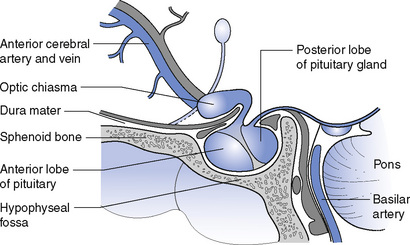7 Endocrine glands
The endocrine glands are organs producing secretions called hormones, which are poured directly into the blood stream from the glandular cells. It is for this reason that they are also known as ductless glands. This chapter is mainly concerned with the overall control of the endocrine system, which is composed of all the endocrine glands, by the pituitary in the brain. The function of the thyroid and parathyroid glands will be considered in some detail along with the adrenal glands, although the gonads, which are also endocrine glands, are considered in Chapter 25.
The pituitary
The pituitary gland lies in the hypophyseal fossa of the sphenoid bone in the base of the skull. It is attached by a neural stalk to the optic chiasma at the base of the brain (Fig. 7.1).
The anterior lobe produces a number of hormones:
Stay updated, free articles. Join our Telegram channel

Full access? Get Clinical Tree



